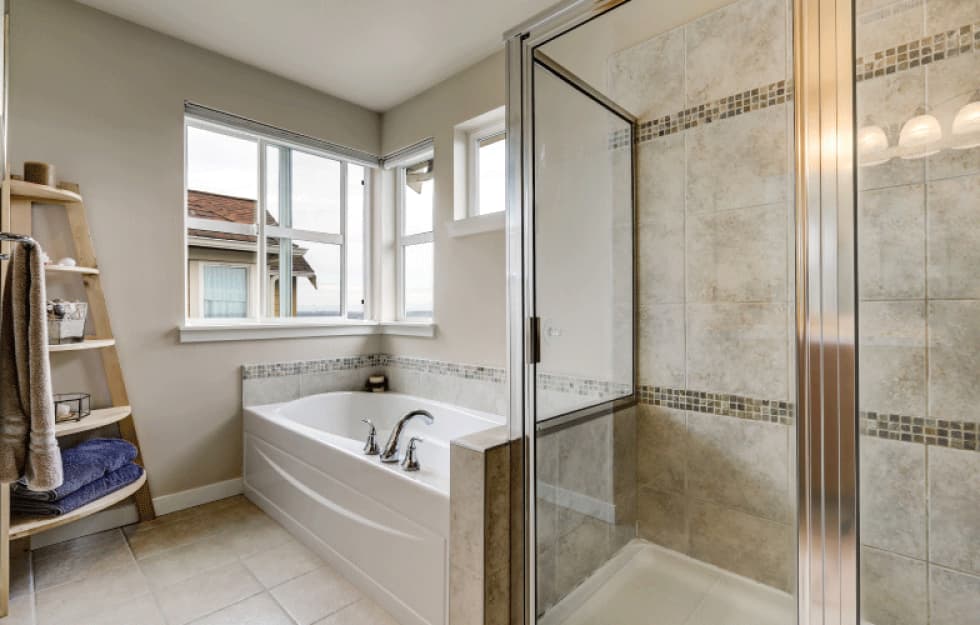At Demers Glass, we’ve been helping homeowners and builders make informed decisions about glass since 1977. Whether you're planning a full bathroom remodel or a simple upgrade, choosing the right shower enclosure is more than a design decision, it's about enhancing comfort, value, and long-term satisfaction.
In this comprehensive guide, we break down every major shower enclosure type, compare framed vs. frameless options, and share expert insights so you can confidently choose what works best for your space.
Understanding the Role of a Shower Enclosure
Before diving into types, it’s important to understand what a shower enclosure truly does. It’s not just a barrier, it sets the tone for your bathroom’s aesthetic, controls moisture, and adds practical functionality.

If you’re new to the topic, we recommend starting with Everything You Need to Know About Shower Enclosures for a big-picture overview.
1. Framed Shower Enclosures
Framed shower doors feature aluminum or stainless-steel framing around all glass panels. They’re popular for their affordability and functionality.
Why Choose a Framed Enclosure?
- Budget-friendly
- High durability
- Secure water sealing
However, framed doors can appear bulkier, and the tracks or frames may collect grime if not maintained regularly.
Expert Tip: Ideal for high-traffic family bathrooms or guest bathrooms where cost-efficiency is key.
Explore how framed styles stack up in Framed, Semi-Frameless, and Frameless Shower Enclosures: Which One Is Right for You?
2. Frameless Shower Enclosures
Frameless designs are the pinnacle of modern elegance. Using thick tempered glass (typically 3/8" to 1/2"), these enclosures provide a sleek, seamless appearance.
Why Go Frameless?
- Minimalist, spa-like style
- Easier to clean (fewer crevices)
- Makes smaller bathrooms feel bigger
Expert Tip:

They’re an investment that pays off in both function and home value.
Explore Four Advantages to Frameless Glass Shower Enclosures for more practical guidance.
3. Semi-Frameless Shower Enclosures
Semi-frameless designs strike a perfect balance, offering the clean look of frameless doors with the stability of a frame around the edges.
Why Choose Semi-Frameless?
- More affordable than frameless
- Visually cleaner than full-frame
- Strong and stable

Expert Tip: This is a great middle-ground for homeowners who want an upgraded look without a fully frameless price tag.
4. Sliding Shower Doors
Sliding (or bypass) doors are functional, especially in tight spaces. They consist of two or more panels that slide past each other on tracks.
When Sliding Doors Shine
- Great for alcove or tub enclosures
- No clearance needed to open
- Available in framed and frameless styles
Expert Tip: Want sliding doors with modern flair? Choose a barn-style sliding system for smooth operation and a trendy twist.
If your bathroom is compact, see our Cool Shower Ideas That Will Transform Your Bathroom for inspiration.
5. Hinged (Pivot) Shower Doors
Hinged doors operate like traditional doors, swinging outward or inward depending on the configuration.
Best for:
- Corner or custom showers
- Walk-in showers with space clearance
- Minimalist designs
Expert Tip: Always measure swing clearance carefully. Pivot doors need room to open fully without obstruction.
6. Bi-Fold Shower Doors
These doors fold inward on hinges, making them ideal for tight spots where sliders or swing doors aren’t feasible.
Why Homeowners Love Them
- Saves space
- Modern feel
- Easier access to the full shower opening
Expert Tip: Bi-folds are great for bathrooms with unusual layouts or accessibility requirements.
7. Neo-Angle Shower Enclosures
Neo-angle designs feature a diamond-shaped footprint, with angled glass panels that maximize corner spaces.
Best for:
- Compact bathrooms
- Modern aesthetics
- Corner installations
Expert Tip: A neo-angle layout with clear glass creates an illusion of more space—perfect for powder rooms or en-suites.
Framed vs. Frameless: What’s Right for You?
This is one of the most common questions we receive at Demers Glass. Let’s break it down:
Still torn? You might enjoy this deep dive: Framed vs. Frameless Shower Enclosures
Professional Advice: How to Choose Your Shower Enclosure
Our team has helped thousands of Arizona homeowners navigate this decision. Here are the top five factors to consider:
- Bathroom Layout – Not all doors work for all spaces. Make sure to factor in door clearance and plumbing locations.
- Style & Materials – Choose glass thickness, tint, and hardware finishes that align with your bathroom’s aesthetic.
- Budget – Plan for product + installation. Framed enclosures are most cost-effective; frameless is a premium upgrade.
- Maintenance Level – Frameless = easy to clean. Framed = more scrubbing.
- Customization Needs – Have an odd shape or size? Frameless or semi-frameless may be the best route.
Explore 6 Tips for Choosing the Perfect Glass Shower Enclosure for a deeper selection strategy.
Frequently Asked Questions (FAQ)
How long does installation take?
Standard enclosures can be installed in as little as one day. Custom work may take longer depending on measurement and fabrication timelines.
Do glass shower enclosures add home value?
Yes. Frameless and modern styles can improve resale appeal and perceived luxury—especially when paired with high-end fixtures.
What’s the safest glass to use?
Tempered glass is the standard for all shower enclosures. It's heat-treated to shatter into small, dull pieces if broken.
What about water spots?
Glass coating solutions and regular squeegee use help prevent buildup. Frameless designs also reduce crevice areas where spots form.
Why Homeowners Trust Demers Glass Since 1977
At Demers Glass, we combine decades of craftsmanship with today’s most innovative glass solutions. Our shower enclosures are fabricated with quality materials and installed with precision by experienced professionals who treat your home like their own.
Whether you're in Scottsdale, Prescott Valley, or the greater Phoenix area, our customer-first approach has helped thousands transform their bathrooms with confidence.
Ready to Transform Your Bathroom?
If you’re planning a remodel or just need guidance on the best shower enclosure for your home, our experts are here to help. Call us, visit one of our Arizona showrooms, or request a free estimate today.
